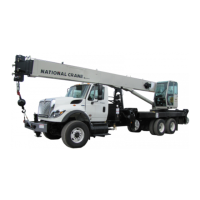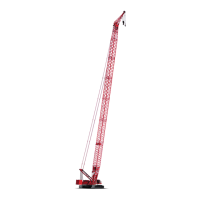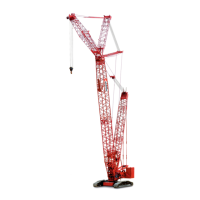OPERATING CONTROLS AND PROCEDURES 14000 OPERATOR MANUAL
3-30
Published 03-29-17, Control # 064-23
Slightly move either crawler handle in the opposite direction
or press BOTTOM of rocker to TURN OFF travel cruise.
H4. Left Crawler Handle or Pedal
H5. Right Crawler Handle or Pedal
The following directions of travel are with front of rotating
bed and front of carbody facing same direction.
• Operator’s cab is at front of rotating bed
• Carbody and crawler control valve is at front of carbody.
If front of rotating bed and front of carbody face in
opposite directions, crane will travel in the direction
opposite handle movement
Push handle FORWARD or depress front of pedal to travel
FORWARD. Brakes release and speed increases in relation
to handle or pedal movement.
Release handle to CENTER to STOP traveling. Brakes
spring apply.
Pull handle BACK or depress rear of pedal to travel in
REVERSE. Brakes release and speed increases in relation
to handle or pedal movement.
Swing/travel alarm beeps to warn personnel when crane is
traveled.
LIMIT DEVICES
See Table 3-2 to determine which limit bypass switch
bypasses a given limit.
1. Boom Maximum Up Limit
Automatically stops boom when it is raised to either of the
following maximum angles:
• 84° for boom with or without fixed jib (without luffing jib)
• 88.5° for boom with luffing jib
Boom can be lowered after the limit is contacted.
2. Boom Down Limit
Automatically stops boom when it is lowered to a preset
minimum angle (usually 0°).
Boom can be raised after the limit is contacted.
The appropriate limit bypass switch must be turned to the
bypass position before the boom can be lowered below the
limit.
3. Block-Up Limit
WARNING
Falling Boom/Jib Hazard!
Do not raise boom above specified maximum angle.
Boom and jib could be pulled over backwards.
WARNING
Falling Boom Hazard!
When lowering boom below down limit, do so slowly with
extreme caution. Do not lower boom to point where less
than three full wraps of wire rope are on boom hoist drum;
wire rope could be pulled out of drums allowing boom to
fall.
WARNING
Two-Blocking Hazard!
If it is necessary to hoist a load above block-up limit, do so
slowly with extreme caution to prevent two-blocking.
Do not hoist load above minimum block clearance given
in Range Diagram (see Capacity Chart Manual).
Do not use limit bypass switch to lower boom or luffing jib
after block-up limit is contacted; two-blocking could occur,
causing load to fall.

